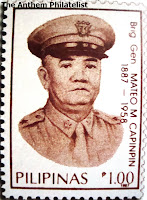The National Anthem of Romania
 Romania's first national anthem in use was "Traiasca Regele", which was used until the deposition of the monarchy on December 30, 1947. The Romanian composer George Enescu quoted this anthem in his "Poème Roumain", op. 1; in performances of Enescu's work during the communist era, this piece was edited out. After the end of the communist regime, this piece was once again played in Enescu's work.
Romania's first national anthem in use was "Traiasca Regele", which was used until the deposition of the monarchy on December 30, 1947. The Romanian composer George Enescu quoted this anthem in his "Poème Roumain", op. 1; in performances of Enescu's work during the communist era, this piece was edited out. After the end of the communist regime, this piece was once again played in Enescu's work.The lyrics are by Vasile Alecsandri, considered one of Romania's great national poets. He was a figure in the 1848 revolution and later in the 1859 union of Moldavia and Walachia, which is considered the founding of modern Romania. The music was by captain Eduard Hubsch, general inspector for military music in Romania.
The second anthem used by the communist government of Romania, "Te slãvim, Românie" was in use until the rule of Ceausescu. One of the authors, Dan Desilu was a poet whose works generally praised the communist government during the early years of communism, but later became disillusioned with the regime. The composer, Matei Socor, was once president of the Composers' Union (which was, at the time, used to extol the Communist government in musical form.)
Starting in the late 1960s, the second verse, referencing the Soviet Union and Leninism, was no longer performed. Then, shortly after, the anthem became officially wordless (two verses were played instrumentally.)
"Trei culori", the anthem during the rule of Nicolai Ceausescu's communist government, is based on a Romanian patriotic song with the same title, the same music, but the text was revised to conform with Communist standards. The title refers to the national flag of Romania, which is a tricolour: red, yellow and blue. The composer, Ciprian Porumbescu also wrote the melody for the Albanian anthem.
After the fall of Ceaucescu in late December, 1989, "Trei Culori" remained the official anthem for several months until replaced by the decomcratic government. "Trei culori" was still played for those months in post-Communist Romania, without the Communist verses, and possibly with the original text.
During the fall of the Communist government in the last days of 1989, the popular song "Desteaptate, romane" was prevalent in the streets and quickly became a kind of "second anthem"; it was officially declared as the anthem in April, 1990, and was also used for a time by Moldova. Written during the 1848 revolution, it has been used by Romanians in their many struggles for freedom, such as from the Nazis in 1944, and during the end of communism, thus becoming the logical choice as a new anthem. The original work has eleven verses, but only four (verses 1, 2, 4, and 11) are the official lyrics.






